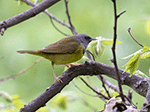Mourning Warbler
Geothlypis philadelphia
| Length: 5.25 inches | Wingspan: 8.25 inches | Seasonality: Migrant |
| ID Keys: Olive upperparts, yellow below. gray hood. Black upper breast on male. | ||
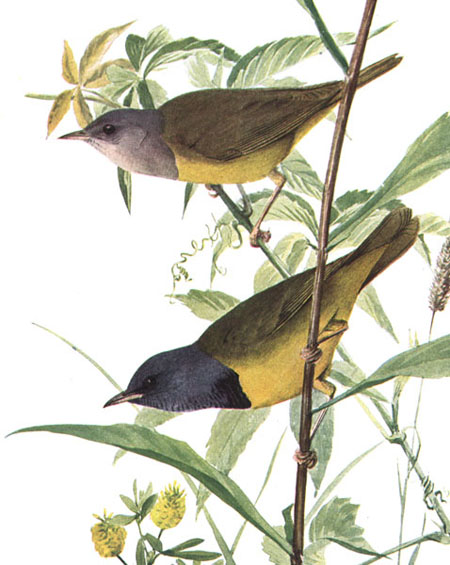 Mourning
Warblers are named after the black patch on the male's upper breast, giving
the impression of being dressed in mourning. The Mourning Warbler is a
bird of shrubby areas and forest undergrowth, and is often difficult to
spot. Unlike many migrants, Mourning Warblers avoid flying over the Gulf
of Mexico during the spring and fall, instead preferring to migrate overland
through Mexico and the interior of the U.S.
Mourning
Warblers are named after the black patch on the male's upper breast, giving
the impression of being dressed in mourning. The Mourning Warbler is a
bird of shrubby areas and forest undergrowth, and is often difficult to
spot. Unlike many migrants, Mourning Warblers avoid flying over the Gulf
of Mexico during the spring and fall, instead preferring to migrate overland
through Mexico and the interior of the U.S.
Habitat:
Mourning Warblers prefer shrubby undergrowth and second-growth forest. They can often be found in forest areas that are regenerating after fire disturbance or clear-cutting. Given their preference for regenerating forest and shrubby lands, they are a species that hasn't been as negatively impacted by forestry activity as many songbird species that prefer more mature forest.
Diet:
Primarily insects, especially caterpillars and beetles. Also spiders.
Behavior:
Moves through low shrubs and forest undergrowth, gleaning insects and spiders from the foliage. Will also fly out to capture flying insects in mid-air, and will forage while hopping along the ground.
Breeding:
Non-breeder in South Dakota. On their breeding range, Mourning Warblers nest on the ground, or in low vegetation close to the ground, typically in thick vegetation but close to a forest edge or clearing. The nest is a bulky cup built of grasses, weed stems, leaves, bits of bark, and other vegetative material, lined with finer material such as hair, fine grasses, or rootlets. The female lays between 3 and 5 eggs, and it is both parents help to incubate them. The young hatch after about 12-14 days. Mourning Warblers have been observed using "injury" displays to lead predators away from nesting sites, pretending to have a broken wing.
Song:
2-part song, with 2nd part lower than the first part, jirry-jirry, jorry-jorry. They also have a flight call of a series of rapid chip notes.
- Click here to hear the song of a Mourning Warbler1
- Click here to hear the calls of a male Mourning Warbler (lower-pitched chips) bringing food to a juvenile at a nest site (high-erpitched chips)2
Migration:
Summers through southern Canada, the northern Midwest, and the northeastern U.S. Neotropical migrant, wintering in Central and South America.
Interactive eBird Map:
Click here to access an interactive eBird map of Mourning Warbler sightings
Similar Species:
There are multiple other warbler species that could be seen in South Dakota that have a similar plumage, with a dark head and yellowish/greenish body. Here are the species most likely to be confused with a Mourning Warbler.
- Connecticut Warbler - Connecticut Warblers are a rare migrant in South Dakota, with plumage patterns that are very similar to a Mourning Warbler. The most obvious difference is the bold light eye-ring on a Connecticut Warbler, while Mourning Warblers have a completely dark head and neck, with no contrasting markings.
- Nashville Warbler - Nashville Warblers are a much more common migrant warbler in South Dakota. They are similar in plumage, with a greenish-yellow upperparts and yellowish underparts. However, Nashville Warblers have a gray head that's lighter in tone than a Mourning Warbler, with a yellow throat instead of a black throat. Nashville Warblers also have an eye-ring that's lacking on a Mourning Warbler.
- MacGillivray's Warbler - MacGillivray's Warblers are very similar in plumage, with a dark head and neck, yellowish-green upperparts, and yellowish underparts. Visually one difference is a broken light eye ring on a MacGillivray's Warbler. However, the easiest way to differentiate the two species is range. MacGillivary's Warblers are birds of western North America, while Mourning Warblers are found in the East. In South Dakota, MacGillivray's Warblers are primarily found in and around the Black Hills, with only a handful of sightings further east in the state. Mourning Warblers are primarily found in the far eastern part of the state, with just a handful of sightings in the western part of the state.
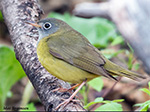 |
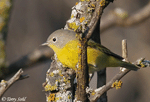 |
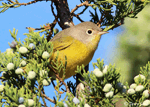 |
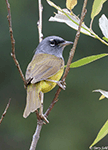 |
| Connecticut Warbler | Nashville Warbler | Nashville Warbler | MacGillivray's Warbler |
Conservation Status:
Systematic surveys in recent decades have shown a modest decline in overall Mourning Warbler populations. However, they are still found across a broad geographic area and have solid numbers in parts of that range. Its preference for second-growth forest makes it less susceptible to habitat loss than many species. The IUCN considers the Mourning Warbler to be a species of "Least Concern".
Further Information:
- USGS Patuxent Bird Identification InfoCenter, Mourning Warbler
- WhatBird - Mourning Warbler
- Audubon Guide - Mourning Warbler
Photo Information:
Painting by Louis Agassiz Fuertes - 1910 - Appeared in "Birds of New York" by Elon Howard Eaton - Copyright expired, public domain in the United States.
Audio File Credits:
- 1Martin St-Michel. Recorded in Quebec on July 13th, 2013. Original recording and information available from xeno-canto.
- 2David Geale. Recorded in Ontario on July 17th, 2011. Original recording and information available from xeno-canto.
| Click on the map below for a higher-resolution view |
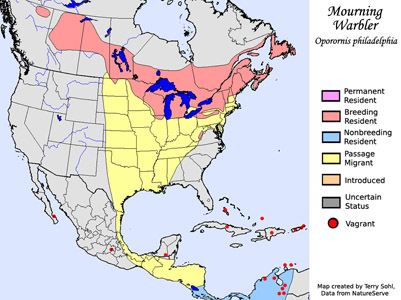 |
| South Dakota Status: Uncommon migrant in the eastern part of the state, accidental in the west. |
Additional Mourning Warbler Photos
